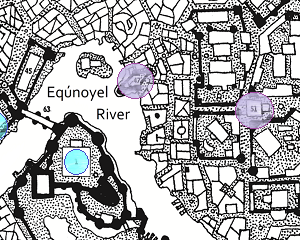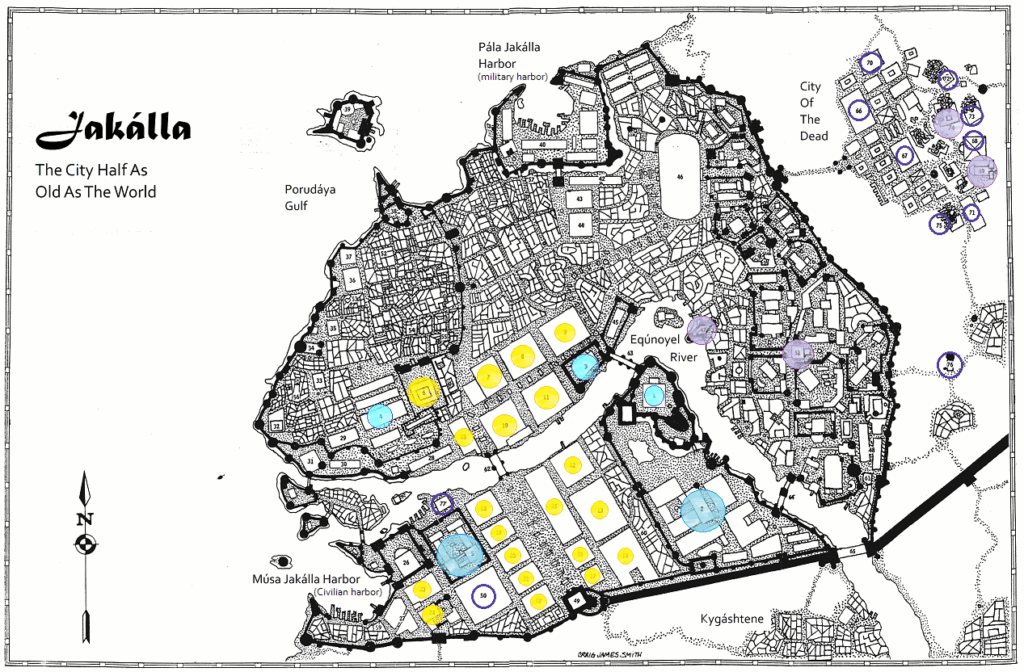
After looking at the above ground parts of the city, we now get to examine the Underworld of Jakálla:
“Within the city precincts of Jakálla itself there are entrances to the ‘Underworld,’ for this is ‘the City Half as Old as the World,’ Princess of the River, Mistress of Cities. Outside of Jakálla lies the City of the Dead, where the Kings of the Bednállja[n] Dynasty sleep the long black sleep secure in their mighty pyramids, guarded with care by the creations of the secret Priesthood of Ksárul. Treasures are to be found beneath these crumbling monuments, men say, and also a variety of hideous deaths at the hands of these undying guardians. ‘Sweet is the harbour, but Death is the ferryman,’ as the old Tsolyáni proverb has it …” (Sec. 1200)
“…there are catacombs and subterranean labyrinths dating from more recent empires, cities, temples, pyramids, and fortresses dedicated to the lost and unremembered gods of half a hundred kingdoms. Another factor is the custom of Ditlána, the ceremonial ‘renewing’ of many cities every 500 years: cellars and foundations of an old city are filled in and roofed over, upper floors are razed, and then new and more splendid edifices are built upon this foundation. Such earlier buried habitations are now full of burrows and tunnels built by humans, half-humans, nonhumans, and the many parasites and predators of Tékumel who subsist upon man’s leavings. Many earlier temples to the Gods of Tékumel — particularly those allied with ‘evil’ — are still maintained in the Underworlds beneath the sprawling modern cities, and it is in these that many of the rich treasures of the ancients are preserved.” (Sec. 1200)
So the question that immediately comes to mind is “how do you get into the Underworld?” (I suppose a more immediate question might be, “why would anybody go there?” but the reasons for seeking adventure, glory, and riches may be obscure.) Before we get into the myriad forms of hidden entrances, I think it is important to consider the institutional forms of access to the Underworld. I would suggest that there are at least four different institutional forms of Underworld access:
- The Temples of the Gods: each of the twenty temples shown on the city map will have their own entrances to the Underworld, to access their underground temples, shrines, storage facilities, and the like. This would include not only the entrances under the temples themselves but also alternative or “secret” entrances elsewhere in the city, for use by secret societies and the like. [Yellow circles on the map below.]
- The Imperial government: The palace of the city governor, as well as the four branches of the Imperial government, specifically the Palaces of the Realm, of the Priesthoods, of Ever-Glorious War, and Foreign Lands. All five of these locations will likely have at least one entrance to the Underworld. Again, there will be other entrances elsewhere, known and used by agents of the Emperor and others. [Blue circles on the map below.]
It is probably worth noting that the Imperial government through the Omnipotent Azure Legion does make use of the tubeway car network left over from the time of the Ancients:
“Certain passages branch off to tie in with still other Underworld complexes; some of these connector tunnels run for miles, being survivals from the ancient pre-cataclysm underground transport system.” (Sec. 2800) - The City of the Dead: the necropolis of Jakálla has two different locations for entrances to the Underworld, specifically:
“Heap of Ruins Said to Be the Temple of Hyáshra, an Ancient Form of the Cohort Hriháyal, the Dancing Maiden of Temptation. [This mound contains at least two entrances to the Underworld which lies below the City of the Dead.]” (and)
“Temple of Sárku, the Master of the Undead, and Headquarters of the Tomb-Police of the City of the Dead.” [note that this temple is in addition to the one in the city proper.] (Sec. 3100) [Purple filled-in circles on the map below.]
It is probably worth noting that the specific entrances to the Underworld from the Temple of Hyáshra are mentioned in Sec. 2810: Developing an Underworld:
“Having selected a hexagon on the surface map of Jakálla as one’s starting point (e.g. no. 74, the heap of ruins said to be the Temple of Hyáshra), one takes the sheet of graph paper destined to become the first level and draws in a stairway leading down from the surface.”
There is still room for further description of where in the aboveground ruins the exact entrance actually is, and any other relevant details. We will come back to this. - Known Places of Mystery. These are places around and outside the city, which would be known to the city guards and others, and which may have entrances to the Underworld (no guarantees!). Beside the specific necropolis entrances, there are more than a dozen more scattered across the necropolis and the city proper, including:
– The rest of the tombs in the City of the Dead, patrolled by the Tomb Police
– “The Tower of Mnéttukeng the Sorcerer. [Now in ruins]”
– “The Tower of Ruvádis, the Wearer of Eyes. [A local wizard of some note.]” (sounds vaguely Mu’ugalavyáni to me…)
– “The Old Citadel of Ssirándar I, King of the Bednálljan Dynasty.”
– “Priestly College of Rerektánu.” This might even be an instructional teaching space.
– “Pyramid Temple of the Ancient Unnamed One (not in use).” (by whom?)
– “The House of the Pleasant Hour, a Branch of the Temple of Dlamélish.”
[Purple circles on the map below.]
What this says is that there are easily seventy different points of access to the Underworld, not counting any others used by other inhabitants of Jakálla, which would likely make the number of Underworld access points over one hundred. Moreover, these access points would change over time, as the need for secrecy would be a driving force in maintaining security.
All of these locations would benefit from a small amount of further detailing of the specific Underworld entrance. This might include a brief description of what it looks like, whether or not there are any gates, doors, or other potential barriers, what guardians might be in place, traps, etc. It may even be worthwhile to develop a key to the entrances to the Underworld, thus connecting the above ground world to the shadowed and hidden depths below. Here is an example to spark your own creativity.
“#23: Temple of Chegárra – temple entrance. The temple entrance to the Underworld is in the 2nd sub-basement, furthest away from the Tunkul-gong tower. It is at the end of what was once a side entrance to the temple, down a 10’ wide sloping ramp 50 feet long. At the top and at the bottom of the ramp there are always two guards (AC4, level 2, HP 11, 8, 9, 10, short halberds and swords), ready to sound the alarm if something unexpected emerges from the depths.”
Besides the institutional entrances, there will be ways to go underground which are more random, less well known, and less controlled by others. By necessity, these entrances are more ephemeral, and more likely to disappear over time. What do those look like, and who would know about them?
- Additional entrances. Scattered across the city, in the Foreigners Quarter and elsewhere, there will be different entrances to the Underworld: in sub-basements of clan houses, entrances through the sewer system, old buildings re-purposed but with left-over passages leading into the depths. With the custom of Ditlána, there will always be passages leading underground, some of which will be random and others will be very carefully planned – but camouflaged to look as dead-ends and collapsed corridors. Moreover, these will change over time.
So what does this mean for running a campaign? It is important to keep in mind what Underworlds are in the larger scheme of things in Tékumel, which are places of mystery. Underworlds are places of plotting, skullduggery, and secret assignations – and the law does not apply underground:
“Hence an open breach of [the] Concordat is treated as high treason and punishable by the most disgraceful death possible in all of the five great empires. This does not preclude secret machinations — and certainly not secret violence in the shadowy reaches of the Underworlds beneath the old cities.” (“Seal of the Imperium” The Dragon #9)
Moreover, unlike D&D dungeons, underworlds in Tékumel are dynamic spaces. Not all of the Underworld will be accessible from all points of access; trying to map the entire Underworld would be impossible, as things will change. Indeed, some entrances may not even stay open over time, and new ones will appear. Again, adventurers will have to seek out friends and allies who may know secret routes and passages.
But in the end, there will be Underworld entrances all over. The exact knowledge of how to get into the depths will be considered a valuable secret, however. Besides the Tomb Police, various priesthoods and imperial officials, there will be secret societies, smugglers, tomb robbers, low and very low status clans involved in construction, sewer maintenance, and public works, and others, who would all have some idea of how to access everything underground – and will sell that knowledge for a decent sum of Káitars.
So for adventurers starting off in the Foreigners Quarter, or possibly in a middle-status clan house, accessing the Underworld is an exciting and dangerous opportunity. It is certainly possible for a low-level party of adventurers to go into the Underworld on their own, especially if they have some assistance (e.g. their clan or temple loans them an Eye, or provides a scroll or amulet). But it is probably better to wait for a patron to appear (c.f. Section 1110), who can act as back-up for the adventurers; “Nature of mission: Join in an expedition to the nearest Underworld.”

